Reminiscing
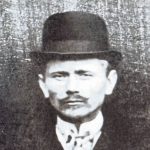
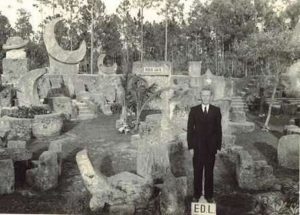 Edward Leedskalnin was a bit of an eccentric, which might have been caused by the sadness of lost love. When Edward was suddenly rejected by his 16 year old fiancée Agnes Skuvst in Latvia, just one day before the wedding, he decided to immigrate to America. Once there, he came down with allegedly terminal tuberculosis, but was spontaneously healed. He believed that magnets had some effect on his disease. I don’t know about that part, but he lived much longer that he was ever expected to.
Edward Leedskalnin was a bit of an eccentric, which might have been caused by the sadness of lost love. When Edward was suddenly rejected by his 16 year old fiancée Agnes Skuvst in Latvia, just one day before the wedding, he decided to immigrate to America. Once there, he came down with allegedly terminal tuberculosis, but was spontaneously healed. He believed that magnets had some effect on his disease. I don’t know about that part, but he lived much longer that he was ever expected to.
Leedskalnin decided to build himself a home where he could live out his years in solitude. The resulting “home” was eventually names Coral Castle, but was originally named “Ed’s Place.” Leedskalnin originally built the castle in Florida City, Florida, around 1923. Florida City, which borders the Everglades, is the southernmost city in the United States that is not on an island. It was an extremely remote location with very little development at the time. Leedskalnin built the castle by himself, out of Oolite Limestone. Edward spent more than 28 years building Coral Castle, refusing to allow anyone to view him while he worked. A few teenagers claimed to have watched his work a few times and reported that he had caused the blocks of coral to move like hydrogen balloons. The only tool that Leedskalnin spoke of using was a “perpetual motion holder”. The stones are fastened together without mortar. They are set on top of each other using their weight to keep them together. The craftsmanship detail is so skillful and the stones are connected with such precision that no light passes through the joints. The 8-foot tall vertical stones that make up the perimeter wall have a uniform height. Even with the passage of decades the stones have not shifted.
Leedskalnin purchased the land from Ruben Moser whose wife had assisted him when he had a very bad bout with tuberculosis. The castle remained in Florida City until about 1936 when Leedskalnin decided to move and take the castle with him. He renamed it “Rock Gate.” The move was an even more amazing feat the the first building of the castle. Its second and final location has the mailing address of 28655 South Dixie Highway, Miami, FL 33033, which now appears within Leisure City but which is actually unincorporated county territory. He reportedly chose relocation as a means to protect his privacy when discussion about developing land in the original area of the castle started. He spent three years moving the component structures of Coral Castle 10 miles north of Florida City to its current location outside Homestead, Florida.
At Florida City, Leedskalnin allowed visitors to the castle, charging them ten cents apiece to tour the castle grounds, but after moving to Homestead, he asked for donations of twenty five cents. Nevertheless, he let visitors enter free if they had no money. There are signs carved into rocks at the front gate to “Ring Bell Twice.” He would come down from his living quarters in the second story of the castle tower close to the gate and conduct the tour. Leedskalnin never told anyone who asked him how he made the castle. He would simply answer “It’s not difficult if you know how.” When Leedskalnin became ill in November 1951, he put a sign on the door of the front gate “Going to the Hospital” and took the bus to Jackson Memorial Hospital in Miami. Leedskalnin suffered a stroke at one point, either before he left for the hospital or at the hospital. He died twenty-eight days later of Pyelonephritis (a kidney infection) at the age of 64. His death certificate noted that his death was a result of “uremia; failure of kidneys, as a result of the infection and abscess.” While the property was being investigated, $3,500 was found among Leedskalnin’s personal belongings. Leedskalnin had made his income from conducting tours, selling pamphlets about various subjects (including magnetic currents) and the sale of a portion of his 10-acre property for the construction of U.S. Route 1. As Leedskalnin had no will, the castle became the property of his closest living relative in America, a nephew from Michigan named Harry. Coral Castle’s website reports that the nephew was in poor health and he sold the castle to an Illinois family in 1953. However, this story differs from the obituary of a former Coral Castle owner, Julius 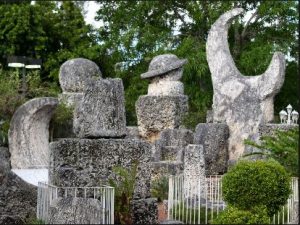
 Levin, a retired jeweler from Chicago, Illinois. The obituary states Levin had purchased the land from the state of Florida in 1952 and may not have been aware there was even a castle on the land. The new owners turned it into a tourist attraction and changed the name of Rock Gate to Rock Gate Park, and later to Coral Castle. In January 1981, Levin sold the castle to Coral Castle, Inc., for $175,000. The company retains ownership today.
Levin, a retired jeweler from Chicago, Illinois. The obituary states Levin had purchased the land from the state of Florida in 1952 and may not have been aware there was even a castle on the land. The new owners turned it into a tourist attraction and changed the name of Rock Gate to Rock Gate Park, and later to Coral Castle. In January 1981, Levin sold the castle to Coral Castle, Inc., for $175,000. The company retains ownership today.
 When people think of plastic surgery, the mind congers up images of everything from severe scar repair to vanity surgeries, but who originally came up with these procedures. Although the development of plastic surgery is popularly believed to have taken place in modern times, the origins of plastic surgery are very old. In the early part of the 1400s, the nose received the most attention from the early plastic surgeons. One of the first procedures for reconstructing the nose, a primitive precursor to the nose job, is attributed to a surgeon called Antonio Branca.
When people think of plastic surgery, the mind congers up images of everything from severe scar repair to vanity surgeries, but who originally came up with these procedures. Although the development of plastic surgery is popularly believed to have taken place in modern times, the origins of plastic surgery are very old. In the early part of the 1400s, the nose received the most attention from the early plastic surgeons. One of the first procedures for reconstructing the nose, a primitive precursor to the nose job, is attributed to a surgeon called Antonio Branca.
After that era, Plastic surgery had to wait until the late 18th century for the next significant advance in its history…the skin graft. And ironically the breakthrough came from rediscovering a procedure developed in ancient India. The severe-looking skin graft procedure was rediscovered in an ancient book called the “Sushruta Samhita,” dating back to 8th century BC. There hidden in the book’s 184 chapters was a technique using a leaf-shaped flap from the forehead to  reconstruct the nose. The technique was published in the ‘Gentleman’s Magazine of Calcutta’ in October 1794 and it soon became widely used. It was known as the “Indian Method”.
reconstruct the nose. The technique was published in the ‘Gentleman’s Magazine of Calcutta’ in October 1794 and it soon became widely used. It was known as the “Indian Method”.
While these methods undoubtedly had a great impact on the history of plastic surgery, it would be another event that would have one of the biggest impacts on plastic surgery, and its methodology. That event was World War I. Shrapnel was the cause of many facial injuries during world War I, and unlike the straight-line wounds inflicted by bullets, the twisted metal shards produced from a shrapnel blast could easily rip a face off. Harold Gillies, a surgeon, was horrified by the injuries he saw, and he immediately took on the task of helping these victims. He saw these men as more than victims. They were heroes, and that’s how he saw them. He knew he had to do something to help these men get back to a normal life. So, he pioneered early techniques of facial reconstruction in the process.
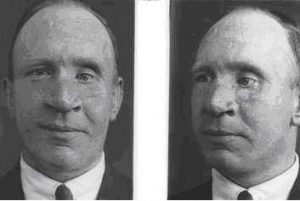 While these were great advances, it’s likely that the most significant improvements in the history of plastic surgery occurred in the last century. Several plastic surgery techniques were introduced during the world wars. Skin grafting techniques such as the “tubed pedicled graft,” were state of the art during World War I. Archibald McIndoe and Harold Gillies refined the techniques to treat severe facial burns. These staged procedures differed from earlier plastic surgery because they relied on the growth and development of a blood supply from the recipient bed into the grafted tissue over many weeks or months. While that all seems pretty normal these days, it was unheard of until then.
While these were great advances, it’s likely that the most significant improvements in the history of plastic surgery occurred in the last century. Several plastic surgery techniques were introduced during the world wars. Skin grafting techniques such as the “tubed pedicled graft,” were state of the art during World War I. Archibald McIndoe and Harold Gillies refined the techniques to treat severe facial burns. These staged procedures differed from earlier plastic surgery because they relied on the growth and development of a blood supply from the recipient bed into the grafted tissue over many weeks or months. While that all seems pretty normal these days, it was unheard of until then.
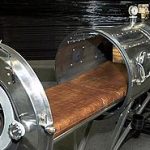 Called an Iron Lung, the negative pressure ventilator was a common tool used to treat polio when that disease was deadly and much feared. Poliomyelitis, which is often called polio or infantile paralysis, is an infectious disease caused by the poliovirus. In about 0.5 percent of cases there is muscle weakness resulting in an inability to move. This can occur over a few hours to a few days. The weakness most often involves the legs but may less commonly involve the muscles of the head, neck and diaphragm. Many people fully recover. In those with muscle weakness about 2 to 5 percent of children and 15 to 30 percent of adults die. Another 25 percent of people have minor symptoms such as fever and a sore throat and up to 5 percent have headache, neck stiffness and pains in the arms and legs. These people are usually back to normal within one or two weeks. In up to 70 percent of infections there are no symptoms. Years after recovery post-
Called an Iron Lung, the negative pressure ventilator was a common tool used to treat polio when that disease was deadly and much feared. Poliomyelitis, which is often called polio or infantile paralysis, is an infectious disease caused by the poliovirus. In about 0.5 percent of cases there is muscle weakness resulting in an inability to move. This can occur over a few hours to a few days. The weakness most often involves the legs but may less commonly involve the muscles of the head, neck and diaphragm. Many people fully recover. In those with muscle weakness about 2 to 5 percent of children and 15 to 30 percent of adults die. Another 25 percent of people have minor symptoms such as fever and a sore throat and up to 5 percent have headache, neck stiffness and pains in the arms and legs. These people are usually back to normal within one or two weeks. In up to 70 percent of infections there are no symptoms. Years after recovery post-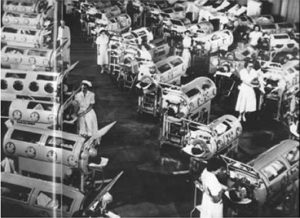 polio syndrome may occur, with a slow development of muscle weakness similar to that experienced during the initial infection. Polio is more common in infants and young children, occurring under conditions of poor hygiene.
polio syndrome may occur, with a slow development of muscle weakness similar to that experienced during the initial infection. Polio is more common in infants and young children, occurring under conditions of poor hygiene.
Because of complete or partial loss of muscle usage, people with polio had a difficult time breathing, which can cause a myriad of problems, including pneumonia. Enter the Emerson iron lung. The affected patient lies within the chamber, which when sealed provides an effectively oscillating atmospheric pressure. A negative pressure ventilator, or iron lung, is a nearly-obsolete mechanical respirator which enables a person to breathe on their own in a normal manner, when muscle control is lost, or the work of breathing exceeds the person’s ability, as may result from certain diseases. Polio was not the only disease that called for the iron lung. In addition to 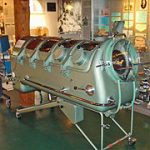 Polio, botulism and certain poisons, such as barbiturates, tubocurarine, also benefited from its use.
Polio, botulism and certain poisons, such as barbiturates, tubocurarine, also benefited from its use.
Versions of the Iron Lung include both the Drinker respirator, the Emerson respirator, and the Both (Emerson-Drinker) respirator. The negative form of pressure ventilation…decreasing surrounding pressure to induce inhalation then re-pressurizing to 1 bar (15 psi; 750 mmHg)…has been almost entirely superseded by positive pressure ventilation (forcing air into the lungs with a pressure greater than 1 bar then allowing the body to naturally exhale before repeating) or negative pressure cuirass ventilation. While the iron lung is not used anymore, it served a useful purpose in its day.
 When I think of people disappearing, my Christian mind automatically envisions the rapture of the church, but there have, of course, been other times when people have disappeared, and some of them were utterly horrifying. One such horrifying version of people disappearing is the nuclear bombings of Hiroshima and Nagasaki. I have never been able to wrap my head around my feelings about the Atomic Bombs that were dropped on August 6 and August 9, 1945, respectively. Though we were at war, the Atomic Bomb seemed such an extreme weapon. Nevertheless, it was what was used those days to show that we meant business.
When I think of people disappearing, my Christian mind automatically envisions the rapture of the church, but there have, of course, been other times when people have disappeared, and some of them were utterly horrifying. One such horrifying version of people disappearing is the nuclear bombings of Hiroshima and Nagasaki. I have never been able to wrap my head around my feelings about the Atomic Bombs that were dropped on August 6 and August 9, 1945, respectively. Though we were at war, the Atomic Bomb seemed such an extreme weapon. Nevertheless, it was what was used those days to show that we meant business.
On August 6th, one of its B-29s dropped a Little Boy uranium gun-type bomb on Hiroshima. Three days later, on August 9th, a Fat Man plutonium implosion-type bomb was dropped by another B-29 on Nagasaki. The bombs immediately devastated their targets. Over the next two to four months, the acute effects of the atomic bombings killed 90,000–146,000 people in Hiroshima and 39,000–80,000 people in Nagasaki…roughly half of the deaths in each city occurred on the first day. Large numbers of people continued to die from the effects of burns, radiation sickness, and other injuries, compounded by illness and malnutrition, for many months afterward. In both cities, most of the dead were civilians, although Hiroshima had a sizable military garrison. While the bombings were met with mixed feelings worldwide, the plan worked. Just six days later, on August 15, 1945, Japan announced its surrender.
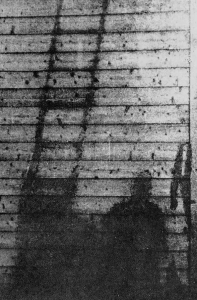
The atomic bombs were successful, but as I said, my feelings were similar to the rest of the world’s feelings. The devastation from the bombs was unbelievable. Those who survived the initial attack died a slow death, and in reality that was the worse way to go. Those who were killed instantly, were in reality obliterated…they simply disappeared. As shocking as that was to me, what I found even more shocking was what was left behind. The atomic bombs basically burned a picture of the victims onto whatever was near them…a wall, stairs, or the side of a building. That was difficult to wrap my head around. When I saw a nuclear shadow of a child playing jump rope that was flashed against the side of a building, my thoughts immediately went to the fact that this child had no idea that his life was about to be over. I don’t suppose there was time for him to feel any pain, and that was probably the most merciful part of the entire horrible event.
The nuclear shadows were everywhere, preserved as vivid reminders of what had taken place. For as long as ten years, the shadows were still there. Then they started to fade. As buildings were remodeled, some of the shadows were removed at preserved in the Hiroshima Peace Memorial Museum. One shadow, thought to be the outline of a person who was sitting at the entrance of Hiroshima Branch of Sumitomo Bank when the atomic bomb was dropped over Hiroshima, is known as Human Shadow of Death. According to the museum, “it is thought that the person had been sitting on the stone step waiting for the bank to open when the heat from the bomb burned the surrounding stone white and left their shadow. A black deposit was also found on the shadow.  A piece of stone containing the artifact was cut from the original location and moved to the museum.” Also, according to museum staff, “many visitors to the museum believe that the shadow is the outline of a human vaporized immediately after the bombing. However, the possibility of human vaporization is not supported from a medical perspective. The ground surface temperature is thought to have ranged from 3,000 to 4,000 degrees Celsius just after the bombing. Exposing a body to this level of radiant heat would leave bones and carbonized organs behind. While radiation could severely inflame and ulcerate the skin, complete vaporization of the body is impossible.” Nevertheless, it appears to have happened, whether they believe it or not.
A piece of stone containing the artifact was cut from the original location and moved to the museum.” Also, according to museum staff, “many visitors to the museum believe that the shadow is the outline of a human vaporized immediately after the bombing. However, the possibility of human vaporization is not supported from a medical perspective. The ground surface temperature is thought to have ranged from 3,000 to 4,000 degrees Celsius just after the bombing. Exposing a body to this level of radiant heat would leave bones and carbonized organs behind. While radiation could severely inflame and ulcerate the skin, complete vaporization of the body is impossible.” Nevertheless, it appears to have happened, whether they believe it or not.
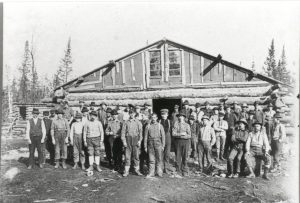
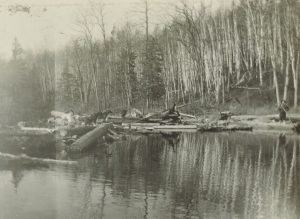 Established as a national forest in 1909, Superior National Forest is located in far northern Minnesota. Big pine timber logging began in the Superior National Forest in the 1890s and continued into the 1920s. Logging was not easy in Superior National Forest, and much of the area remained untouched because of the border lakes region, which presented numerous challenges to the logging companies in accessing and harvesting the stands of timber. In the 1890s, vast extents of the border lakes forests had been stripped away in Michigan and Wisconsin. The early logging was accomplished by means of river driving of logs. That was one of the types of logging that my grandfather was involved in. The logs were cut down,and then floated down the river to the saw mills. The method was a good one, but it could also be dangerous. Many a man was pinched between the logs, and many died. I’m very thankful my grandfather, Allen Luther Spencer was not one of those poor men who lost their lives doing this job. As timber near rivers became depleted, railroad logging became the primary method of getting the wood to the mill. Frozen ground conditions in the winter steered the logging industry to build ice roads providing greater access to timber stands. Logging after 1929 focused more and more on pulp species and the wood products industry.
Established as a national forest in 1909, Superior National Forest is located in far northern Minnesota. Big pine timber logging began in the Superior National Forest in the 1890s and continued into the 1920s. Logging was not easy in Superior National Forest, and much of the area remained untouched because of the border lakes region, which presented numerous challenges to the logging companies in accessing and harvesting the stands of timber. In the 1890s, vast extents of the border lakes forests had been stripped away in Michigan and Wisconsin. The early logging was accomplished by means of river driving of logs. That was one of the types of logging that my grandfather was involved in. The logs were cut down,and then floated down the river to the saw mills. The method was a good one, but it could also be dangerous. Many a man was pinched between the logs, and many died. I’m very thankful my grandfather, Allen Luther Spencer was not one of those poor men who lost their lives doing this job. As timber near rivers became depleted, railroad logging became the primary method of getting the wood to the mill. Frozen ground conditions in the winter steered the logging industry to build ice roads providing greater access to timber stands. Logging after 1929 focused more and more on pulp species and the wood products industry.
Soon, it became evident that the logging industry, while a good a profitable industry, had the potential to deplete the natural resources in the Superior National Forest. In 1921, Arthur Carhart (Forest Landscape Architect) published “Preliminary Prospectus: An Outline Plan for the Recreational Development of the Superior National Forest.” It was released following a survey conducted by Carhart and Forest Guard Soderback in the Boundary Waters region. This publication began to set the framework for the future designation of the BWCAW.
In 1930, Shipstead-Newton-Nolan Act was passed placing restrictions aimed at preserving the wilderness nature of lake and stream shorelines. By 1934, President Franklin D. Roosevelt designated the Quetico-Superior Committee to work with government agencies in the conservation, preservation, and use of northeast Minnesota’s wilderness areas. 1948 brought the Thye-Blatnik Act authorized the federal government to acquire private land holdings within roadless areas, thereby increasing federal acreage within the boundary waters roadless area. In 1949, the passage of Executive Order #10092, established an airspace boundary over the boundary waters roadless area. Highly controversial, this order effectively ended a particular type of recreation in the boundary waters, that of the remote fly-in resort. Resort operators had until 1951 to halt air traffic within 4000 feet of the roadless area.In 1958, The Superior Roadless Areas were renamed the Boundary Waters Canoe Area (BWCA). Conflict over motorized use in the roadless area increased during this time. The passage of the national Wilderness Act in 1964, with special provision regarding the BWCA, allowed some motorized use 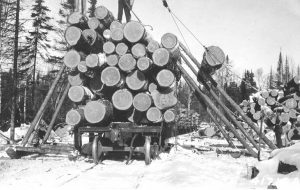
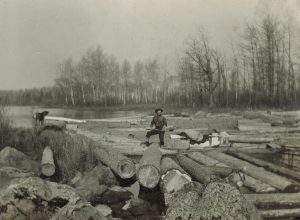 and logging within the Boundary Water’s wilderness boundaries, but by 1978, with the passage of the Boundary Waters Canoe Area Wilderness Act, which was specific to the BWCAW. This legislation eliminated logging and snowmobiling, restricted mining and allowed motorboats on 1/4 of the water area. While logging is necessary, I can’t help but agree with the preservation of the beautiful Superior National Forest.
and logging within the Boundary Water’s wilderness boundaries, but by 1978, with the passage of the Boundary Waters Canoe Area Wilderness Act, which was specific to the BWCAW. This legislation eliminated logging and snowmobiling, restricted mining and allowed motorboats on 1/4 of the water area. While logging is necessary, I can’t help but agree with the preservation of the beautiful Superior National Forest.
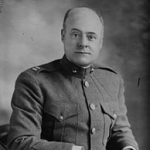 Anthony Joseph Drexel Biddle I (1874–1948) was an eccentric millionaire whose fortune allowed him to pursue theatricals, self-published writing, athletics, and Christianity on a full-time basis. He was the man upon whom the book “My Philadelphia Father” and the play and film “The Happiest Millionaire” were based, but even before that Biddle was eccentric…to say the least. Biddle was a trainer in hand-to-hand combat in both World War I and World War II. In fact, Biddle was an expert in hand-to-hand combat. He also had an unusual way of training his men. It was not unusual for Biddle to tell his trainees to attempt to kill him!! I can’t say for sure that he allowed them to use live ammunition, but he did give them “chance” to try to kill him before he could disarm them.
Anthony Joseph Drexel Biddle I (1874–1948) was an eccentric millionaire whose fortune allowed him to pursue theatricals, self-published writing, athletics, and Christianity on a full-time basis. He was the man upon whom the book “My Philadelphia Father” and the play and film “The Happiest Millionaire” were based, but even before that Biddle was eccentric…to say the least. Biddle was a trainer in hand-to-hand combat in both World War I and World War II. In fact, Biddle was an expert in hand-to-hand combat. He also had an unusual way of training his men. It was not unusual for Biddle to tell his trainees to attempt to kill him!! I can’t say for sure that he allowed them to use live ammunition, but he did give them “chance” to try to kill him before he could disarm them.
An officer in the United States Marine Corps, Biddle was an expert in close-quarters fighting and the author of “Do or Die: A Supplementary Manual on Individual Combat,” a book on combat methods, including knives and empty-hand skills, training both the United States Marine Corps in two world wars and Special Agents of the Federal Bureau of Investigation. He was considered not just an expert in fighting, but also a pioneer of United States Marine Corps training in the bayonet and hand-to-hand combat. He based his style on fencing, though this approach was sometimes criticized as being unrealistic for military combat. At one point, when it looked like there was no way out of a drill he assigned to his men…they were surrounding him, and for all intents and 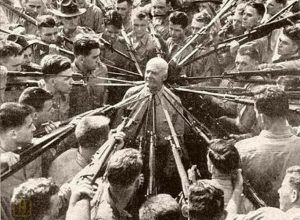 purposes, they had him. Nevertheless, the outcome was not what anyone would have expected, because within in a few minutes, Biddle had completely disarmed each and every one of the men.
purposes, they had him. Nevertheless, the outcome was not what anyone would have expected, because within in a few minutes, Biddle had completely disarmed each and every one of the men.
Born on October 1, 1874 in Philadelphia, Pennsylvania, to Edward Biddle II and Emily Drexel, Anthony was grandson of banker Anthony Joseph Drexel, and great-grandson of banker Nicholas Biddle. Biddle was a graduate of Germany’s Heidelberg University. He was a fellow of the American Geographical Society and founded a movement called “Athletic Christianity” that eventually attracted 300,000 members around the world. A 1955 Sports Illustrated article called him “boxing’s greatest amateur” as well as a “major factor in the re-establishment of boxing as a legal and, at that time, estimable sport.” He joined the Marines in 1917 at the age of 41, and convinced his superiors to include boxing in Marine Corps recruit training. In 1919, he was promoted to the rank of major, and became a lieutenant colonel in 1934. In Lansdowne, Pennsylvania, right outside of Philadelphia, Biddle opened a military training facility, where he trained 4,000 men. His training included long hours of calisthenics and gymnastics, and taught skills such as machete, saber, dagger, bayonet combat, hand grenade use, boxing, wrestling, savate and jiujitsu. He also served two years in the National Guard.
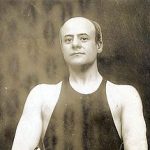 In 1895, he married Cordelia Rundell Bradley. Their marriage was blessed with three children, Anthony Joseph Drexel Biddle Jr. (1897–1961), who married Mary Duke (1887–1960). They were the parents of Mary Duke Biddle (1920–2012) and Nicholas Benjamin Duke Biddle. Their second child was Cordelia Drexel Biddle (1898–1984), who married Angier Buchanan Duke (1884–1923), the son of Benjamin Newton Duke. They were the parents of Angier Biddle Duke (1915–1995) and Anthony Drexel Duke (1918-2014). Their third child was Livingston Ludlow Biddle (1899–1981), who married Kate Raboteau Page (b. 1903), daughter of Robert N. Page. They were the parents of Livingston Ludlow Biddle III. Biddle died May 27, 1948 from a cerebral hemorrhage and uremic poisoning.
In 1895, he married Cordelia Rundell Bradley. Their marriage was blessed with three children, Anthony Joseph Drexel Biddle Jr. (1897–1961), who married Mary Duke (1887–1960). They were the parents of Mary Duke Biddle (1920–2012) and Nicholas Benjamin Duke Biddle. Their second child was Cordelia Drexel Biddle (1898–1984), who married Angier Buchanan Duke (1884–1923), the son of Benjamin Newton Duke. They were the parents of Angier Biddle Duke (1915–1995) and Anthony Drexel Duke (1918-2014). Their third child was Livingston Ludlow Biddle (1899–1981), who married Kate Raboteau Page (b. 1903), daughter of Robert N. Page. They were the parents of Livingston Ludlow Biddle III. Biddle died May 27, 1948 from a cerebral hemorrhage and uremic poisoning.
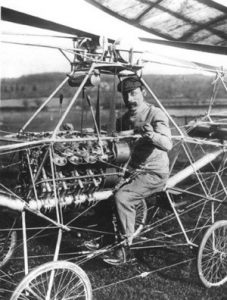 After the Wright brothers discovered a way to make a plane fly, all bets were off as to where the future would take us. It didn’t take very long to find out either. By 1907, a man named Paul Cornu came up with an entirely different type of aircraft, and built the Cornu Helicopter. As most of us know these days, the helicopter is a rotary-wing aircraft that creates its own lift. The Cornu helicopter was an experimental helicopter that was built in France. The craft had an open framework, that obviously didn’t provide much protection from the elements, and so was somewhat limited in when it could fly, but then there are still times when a helicopter can’t fly, so I guess that not much has changed in that respect.
After the Wright brothers discovered a way to make a plane fly, all bets were off as to where the future would take us. It didn’t take very long to find out either. By 1907, a man named Paul Cornu came up with an entirely different type of aircraft, and built the Cornu Helicopter. As most of us know these days, the helicopter is a rotary-wing aircraft that creates its own lift. The Cornu helicopter was an experimental helicopter that was built in France. The craft had an open framework, that obviously didn’t provide much protection from the elements, and so was somewhat limited in when it could fly, but then there are still times when a helicopter can’t fly, so I guess that not much has changed in that respect.
Cornu was a bicycle maker, and so he built his craft around a curved steel tube that carried a rotor at either end, and the engine and pilot in the middle. Power was transmitted to the rotors by a drive belt that linked both rotors and spun them in opposite directions. Control was to be provided by cables that could alter the pitch of the rotor blades, and by steerable vanes at either end of the machine intended to direct the down wash of the rotors. On November 13, 1907, the helicopter was ready for its test flight. The Cornu helicopter is reported to have made a number of short hops, rising perhaps 5–7 feet into the air and staying aloft for something less than one minute…just long enough for Cornu to learn that the control systems he had designed were ineffective. He abandoned the machine soon thereafter. I find it sad to think that, while the design wasn’t going to work in it’s present form, it was certainly not something to give upon. I’m reminded of the old saying, “If at first you don’t succeed…try, try again.” Perhaps, if Paul Cornu had kept trying, he could have succeeded.
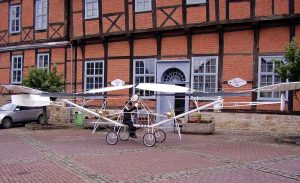 Modern engineering analyses have demonstrated that the Cornu helicopter could not have been capable of sustained flight. The design was flawed, nevertheless, in order to commemorate the centenary of his achievement, a replica of the helicopter was constructed by the École supérieure des techniques aéronautiques et de construction automobile (ESTACA) and presented to the Musée de l’Air et de l’Espace where it was placed on display on December 15, 2007. Another replica was also built. This one by the Hubschraubermuseum Bückeburg (Helicopter Museum of Bückeburg) to pay homage to the merits of Paul Cornu. It has been on display there since November 13, 2007. Though its fight was short, it did fly, after all.
Modern engineering analyses have demonstrated that the Cornu helicopter could not have been capable of sustained flight. The design was flawed, nevertheless, in order to commemorate the centenary of his achievement, a replica of the helicopter was constructed by the École supérieure des techniques aéronautiques et de construction automobile (ESTACA) and presented to the Musée de l’Air et de l’Espace where it was placed on display on December 15, 2007. Another replica was also built. This one by the Hubschraubermuseum Bückeburg (Helicopter Museum of Bückeburg) to pay homage to the merits of Paul Cornu. It has been on display there since November 13, 2007. Though its fight was short, it did fly, after all.
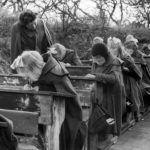 Tuberculosis was a disease that brought terror to the hearts of people over the years…especially right after World War II, but even before World War II, being diagnosed with Tuberculosis was like being given a death sentence. People had to be quarantined, so they wouldn’t infect those around them, since the disease is airborne. All too often it was too late by the time they knew they needed to be quarantined. Any serious disease can be scary for the people in areas affected, but this one was taken to a completely different level. In an effort to prevent Tuberculosis from being passed from child to child, the schools began a new movement, known as the Open-Air School. The movement required the establishment of schools that combined medical surveillance with A method of learning that was adapted to students with pre-tuberculosis…an obsolete term for the pre-clinical stage of tuberculosis. The new institution was established by doctors researching new prophylactic methods, and educators interested in an open air educational experience.
Tuberculosis was a disease that brought terror to the hearts of people over the years…especially right after World War II, but even before World War II, being diagnosed with Tuberculosis was like being given a death sentence. People had to be quarantined, so they wouldn’t infect those around them, since the disease is airborne. All too often it was too late by the time they knew they needed to be quarantined. Any serious disease can be scary for the people in areas affected, but this one was taken to a completely different level. In an effort to prevent Tuberculosis from being passed from child to child, the schools began a new movement, known as the Open-Air School. The movement required the establishment of schools that combined medical surveillance with A method of learning that was adapted to students with pre-tuberculosis…an obsolete term for the pre-clinical stage of tuberculosis. The new institution was established by doctors researching new prophylactic methods, and educators interested in an open air educational experience.
In 1904, Dr Bernhard Bendix and pedagogue Hermann Neufert founded the first school of this kind: the Waldeschule of Charlottenburg, near Berlin, Germany. Classes were conducted in the woods to offer open-air therapy to young city dwellers with pre-tuberculosis. The experiment, conducted by the International Congresses of Hygiene, was immediately attempted throughout Europe and North America: in Belgium in 1904, in Switzerland, England, Italy, and France in 1907, in the United States in 1908, in Hungary in 1910, and in Sweden in 1914. The schools were called “schools of the woods” or “open air schools.” Often they were remote from cities, set up in tents, prefabricated barracks, or re-purposed structures, and were run during the summer. Some of the more noteworthy experiments were the School in the Sun, in Cergnat, Switzerland and the school of Uffculme near Birmingham, England. 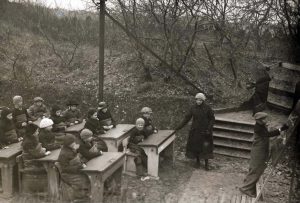 The School of the Sun used helio-therapy in 1910. Dr Auguste Rollier sent the children up to the mountains every morning equipped with portable equipment. The school of Uffculme, noted for its architecture, allowed each class to occupy its own independent pavilion in 1911.
The School of the Sun used helio-therapy in 1910. Dr Auguste Rollier sent the children up to the mountains every morning equipped with portable equipment. The school of Uffculme, noted for its architecture, allowed each class to occupy its own independent pavilion in 1911.
After World War I the movement became organized. The first International Congress took place in Paris in 1922, at the initiative of The League for Open Air Education created in France in 1906, and of its president, Gaston Lemonier. There were four more congresses: in Belgium in 1931; in Germany in 1936, marked by the involvement of German doctor Karl Triebold; in Italy in 1949; and in Switzerland in 1956. National committees were created. Jean Duperthuis, a close associate of Adolphe Ferrière (1879–1960), the well-known pedagogue and theorist of New Education, created the International Bureau of Open Air Schools to collect information on how these schools worked. Testimonies described an educational experience inspired by New Education, with much physical exercise, regular medical checkups, and a closely monitored diet, but there has been little formal study of the majority of these schools.
According to the ideas of the open air school, the architecture had to provide wide access to the outdoors, with large bay windows and a heating system that would permit working with the windows open. The most remarkable of these schools were in Amsterdam, Holland by architect Jan Duiker (1929–1930), in Suresnes, France by Eugène Beaudoin and Marcel Lods (1931–1935), and Copenhagen, Denmark by Kai Gottlob (1935–1938). From what I have seen, most of these school were held completely outdoors. I don’t know if the impact on Tuberculosis was as profound as they had hoped, but there were good things that came out of the  experiments. The movement had an influence on the evolution of education, hygiene, and architecture. School buildings, for example, adopted the concept of classes open to the outdoors, as in Bale, Switzerland (1938–1939, architect Hermann Baur), Impington, England (1939, Walter Gropius and Maxwell Fry), and in Los Angeles (1935, Richard Neutra). This influence is the major contribution of the open air schools movement, although the introduction of antibiotics, which increasingly provided a cure for Tuberculosis, pretty much made them obsolete after World War II. Nevertheless, fresh air, exercise, and playtime for young children have all remained an important part of the school day, and thankfully, Tuberculosis is on the decline, although it still ranks in the top 10 of fatal diseases.
experiments. The movement had an influence on the evolution of education, hygiene, and architecture. School buildings, for example, adopted the concept of classes open to the outdoors, as in Bale, Switzerland (1938–1939, architect Hermann Baur), Impington, England (1939, Walter Gropius and Maxwell Fry), and in Los Angeles (1935, Richard Neutra). This influence is the major contribution of the open air schools movement, although the introduction of antibiotics, which increasingly provided a cure for Tuberculosis, pretty much made them obsolete after World War II. Nevertheless, fresh air, exercise, and playtime for young children have all remained an important part of the school day, and thankfully, Tuberculosis is on the decline, although it still ranks in the top 10 of fatal diseases.
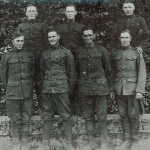 This day…Armistice Day was sometimes called the end of the war to end all wars. The phrase came from a book, and was really an idealistic statement, because as we all know there will always be a war somewhere. Nevertheless, it must have been overwhelming to think of basically the whole world at war. I’m sure the writer of the book, H G Wells, as well as many other people, hoped that through this awful war, humans could somehow learn to live with one another in peace. While that was not to be, this war, like every war, finally comes to an end. Armistice Day marks the armistice signed between the Allies of World War I and Germany at Compiègne, France, for the cessation of hostilities on the Western Front of World War I, which took effect at eleven o’clock in the morning, on the “eleventh hour of the eleventh day of the eleventh month” of 1918. That was, of course, 100 years ago today. Armistice Day is a national holiday in France. It coincides with Remembrance Day in England, and Veterans Day in the United States, and all three are really commemorating the same thing…the end of World War I. And all three are observed as a time to remember those heroes who served their country in that and all other wars. It is a day to remember those who fought and
This day…Armistice Day was sometimes called the end of the war to end all wars. The phrase came from a book, and was really an idealistic statement, because as we all know there will always be a war somewhere. Nevertheless, it must have been overwhelming to think of basically the whole world at war. I’m sure the writer of the book, H G Wells, as well as many other people, hoped that through this awful war, humans could somehow learn to live with one another in peace. While that was not to be, this war, like every war, finally comes to an end. Armistice Day marks the armistice signed between the Allies of World War I and Germany at Compiègne, France, for the cessation of hostilities on the Western Front of World War I, which took effect at eleven o’clock in the morning, on the “eleventh hour of the eleventh day of the eleventh month” of 1918. That was, of course, 100 years ago today. Armistice Day is a national holiday in France. It coincides with Remembrance Day in England, and Veterans Day in the United States, and all three are really commemorating the same thing…the end of World War I. And all three are observed as a time to remember those heroes who served their country in that and all other wars. It is a day to remember those who fought and 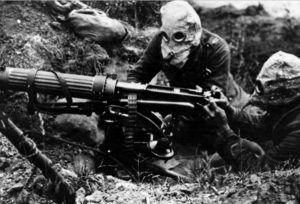 then returned home, but we can’t forget those who didn’t return home either.
then returned home, but we can’t forget those who didn’t return home either.
Because World War I ended on November 11, 1918, we have continued to remember November 11 as Veterans Day, Armistice Day, and Remembrance Day in honor of our soldiers. The armistice initially expired after a period of 36 days. A formal peace agreement was only reached when the Treaty of Versailles was signed the following year, but the Armistice was the beginning. It paved the way, and sometimes that is what is needed the most at a certain low time in history, or in life. Just a glimmer of hope can change the way we feel about things in a big way. It doesn’t matter what name is attached to the day, its all about the meaning of the day that matters. Our veterans have done so much for people they don’t even know, and they all deserve to be recognized for their very heroic acts.
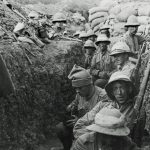 The date is a national holiday in France, England, the United States, and was also declared a national holiday in many Allied nations. In some countries Armistice Day coincides with Remembrance Day and Veterans Day, and other public holidays. Armistice Day is not celebrated in Germany, but a German national day of mourning, Volkstrauertag, has been observed on the Sunday closest to 16 November since 1952. However the day is observed, it is always a day to remember the sacrifice of our soldiers. The day is always celebrated as a day to honor those who served. We can all relate to that, because we all know a veteran, and we all consider them to be honorable people. So, no matter how each country celebrates it or what they call it, we honor our veterans today. Happy Veterans Day!!
The date is a national holiday in France, England, the United States, and was also declared a national holiday in many Allied nations. In some countries Armistice Day coincides with Remembrance Day and Veterans Day, and other public holidays. Armistice Day is not celebrated in Germany, but a German national day of mourning, Volkstrauertag, has been observed on the Sunday closest to 16 November since 1952. However the day is observed, it is always a day to remember the sacrifice of our soldiers. The day is always celebrated as a day to honor those who served. We can all relate to that, because we all know a veteran, and we all consider them to be honorable people. So, no matter how each country celebrates it or what they call it, we honor our veterans today. Happy Veterans Day!!
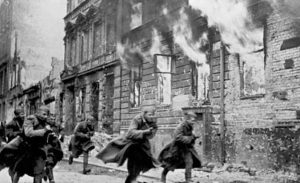 Kristallnacht, translated “Crystal Night,” referred to as the Night of Broken Glass, was an atrocious pogrom against Jews throughout Nazi Germany that took place on November 9–10, 1938. It was carried out by Sturmabteilung (SA) paramilitary forces and civilians. The German authorities looked on without intervening as the mobs tore through the towns. The attacks were said to be retaliation for the assassination of the Nazi German diplomat Ernst vom Rath by Herschel Grynszpan, a seventeen year old German-born Polish Jew living in Paris. I guess I don’t understand why the act of one person should cost the lives of so many.
Kristallnacht, translated “Crystal Night,” referred to as the Night of Broken Glass, was an atrocious pogrom against Jews throughout Nazi Germany that took place on November 9–10, 1938. It was carried out by Sturmabteilung (SA) paramilitary forces and civilians. The German authorities looked on without intervening as the mobs tore through the towns. The attacks were said to be retaliation for the assassination of the Nazi German diplomat Ernst vom Rath by Herschel Grynszpan, a seventeen year old German-born Polish Jew living in Paris. I guess I don’t understand why the act of one person should cost the lives of so many.
The name Kristallnacht comes from the shards of broken glass that littered the streets after the windows of Jewish-owned stores, buildings, and synagogues were smashed. Of course, the carnage didn’t stop with the windows. Estimates of the number of fatalities caused by the pogrom have varied. Reports in 1938 estimated that 91 Jews were murdered during the attacks, but modern analysis of German scholarly sources by historians such as Sir Richard Evans puts the number much higher. It also includes deaths 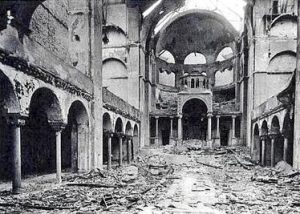 from post-arrest maltreatment and subsequent suicides as well, and puts the death toll into the hundreds. Additionally, 30,000 Jewish men were arrested and incarcerated in concentration camps. The numbers of those killed there are unknown, but we can easily imagine based on what we know of the Holocaust.
from post-arrest maltreatment and subsequent suicides as well, and puts the death toll into the hundreds. Additionally, 30,000 Jewish men were arrested and incarcerated in concentration camps. The numbers of those killed there are unknown, but we can easily imagine based on what we know of the Holocaust.
Breaking windows wasn’t enough for these mobs either. Jewish homes, hospitals, and schools were ransacked, as the attackers demolished buildings with sledgehammers. The rioters destroyed 267 synagogues throughout Germany, Austria, and the Sudetenland, and over 7,000 Jewish businesses were either destroyed or damaged. The British historian Martin Gilbert wrote that no event in the history of German Jews between 1933 and 1945 was so widely reported as it was happening, and the accounts from the foreign journalists working in Germany sent shock waves around the world. At that time it was still hard to believe that mobs of lawless people could  exist, but that was 80 years ago. These days we have no problem believing it, because these actions are almost commonplace.
exist, but that was 80 years ago. These days we have no problem believing it, because these actions are almost commonplace.
The British newspaper The Times wrote at the time: “No foreign propagandist bent upon blackening Germany before the world could outdo the tale of burnings and beatings, of blackguardly assaults on defenseless and innocent people, which disgraced that country yesterday.” Kristallnacht was followed, of course, by additional economic and political persecution of Jews, and it is viewed by historians as part of Nazi Germany’s broader racial policy, and the beginning of the Final Solution and The Holocaust.

